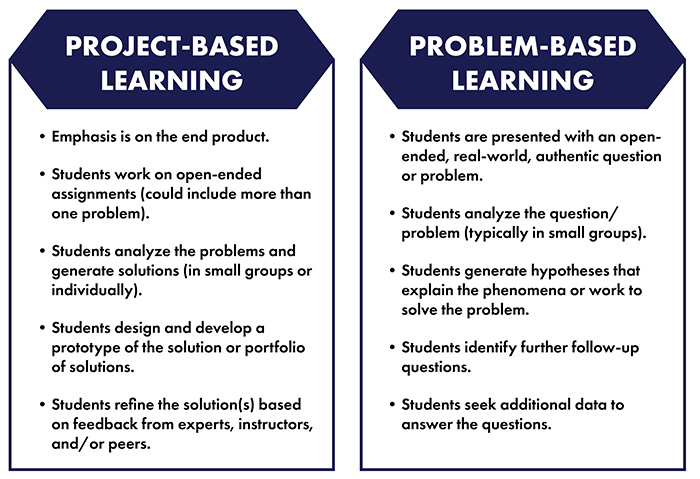Innovative Course Design
Flipped Classroom
The basic premise of the flipped classroom is that class time is best spent on active learning and higher order thinking, while content delivery can successfully take place outside of the classroom. A typical flipped classroom may involve students watching lecture videos or reading course material on their own prior to class, and then working together in class to analyze, evaluate, and apply what they have learned. This model allows for self-paced learning outside of the classroom, while promoting practice-and-feedback loops and collaborative learning inside the classroom. Designing a successful flipped classroom involves a number of steps:
- Developing in-class learning experiences and practice opportunities aligned with course learning goals
- Curating content for out-of-class learning (selecting readings, creating video lectures, etc.)
- Creating structures to support out-of-class learning (reading guides, video quizzes, etc.)
Project-Based Learning and Problem-Based Learning
Project-based learning involves students in addressing complex problems and authentic audiences. Project-based learning involves designing and executing long-term, collaborative, student-driven projects that apply academic research and knowledge to issues beyond the classroom. PBL projects often involve communicating information to broader audiences (for example by creating a publication, podcast, video, website, or community pop-up event) or developing solutions to meet community needs (for example starting a campus rooftop garden, crafting educational curricula, or designing medical devices). Unlike traditional project assignments, PBL projects are always collaborative, requiring extensive exercise of teamwork, time-management, and professional communication skills.
Problem-based learning starts with identifying open-ended, real-life problems (so called “ill-structured” problems) and seeking solutions through a collaborative, student-led process in which the professor plays the role of facilitator. Problem-Based Learning promotes self-directed learning and offers practice in metacognitive and self-assessment skills, as students take ownership of their own and their peers’ learning, and of the problem-solving process itself. Students work in groups to assess possible solutions and methodologies before designing a course of action in response to the problems they have selected. Problem-Based learning is characterized by flexibility and a high degree of student agency.

Community-Based Learning
The community-based learning model supports authentic learning experiences based on meaningful relationships with community partners. While time- and preparation-intensive, community-based learning can be a rewarding, even transformative, experience, allowing students to grapple with messy real-life problems and to transfer academic skills beyond the classroom. Community-based learning pedagogy makes extensive use of reflection to help students understand learning processes that may not be immediately recognizable to those accustomed to more traditional classroom experiences. When planning community-based learning experiences, it is important that the arrangement is mutually beneficial, and that academic partners and community partners establish clear goals and expectations. Awareness of the power structures informing relationships between academic institutions and non-academic partners is imperative: community partners should never be positioned as passive recipients of services, or as exoticised sites of internal tourism. Rather, the goal is to create respectful, authentic, reciprocal communities of learning.
Check out Drexel University's Lindy Center for Civic Engagement for professional support in designing and conducting CBL courses
Case-Based Learning
Case-Based Learning is a highly participatory teaching approach that involves students in real-life simulations and extensive discussion (small-group or whole-class) to address complex problems. Case-Based Learning involves more curation and faculty guidance than Problem-Based Learning, resulting in more structured learning experiences. Case-Based methodology has been used extensively in the sciences and in pre-professional fields including law, business, and medicine. Case-Based Learning requires students to grapple with ambivalence, think critically, articulate their position, identify bias, and collaborate to find solutions. The narrative component of cases activates student emotions and gives contextual grounding to the problems under consideration.
Reacting to the Past
Originally developed in the field of history, Reacting to the Past is a deeply immersive pedagogy that involves interactive game-like scenarios, where students assume historical roles (some real, some fictional) and play out historical events, with emphasis on negotiating pivotal historical moments (the formation of democratic structures, labor struggles, peace agreements, drafting laws and constitutions, etc.). Students remain in character for the duration of the term, and have the power to steer historical scenarios in new directions, experimenting with alternative historical outcomes. Homework in a RTTP class entails in-depth archival research on the role personas, and preparation for in-class interactions. A number of published and unpublished game manuals offer guidance in designing RTTP classrooms and curating course reading portfolios. The immersive methodology has been adapted in a number of fields beyond history, including STEM disciplines. While teaching a full-on RTTP course might not be an option for most faculty, elements of immersive pedagogy (in-character debates, role-playing, real-life simulations) can be adopted in many courses across multiple disciplinary contexts.
Next: Additional Resources and References